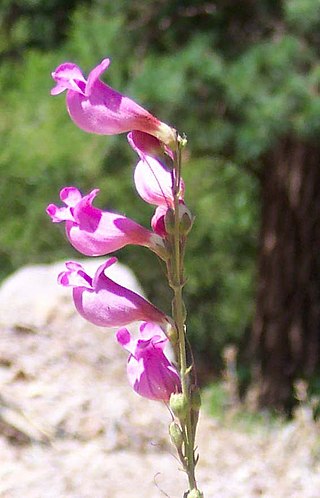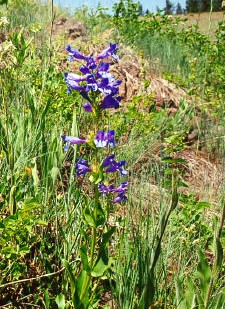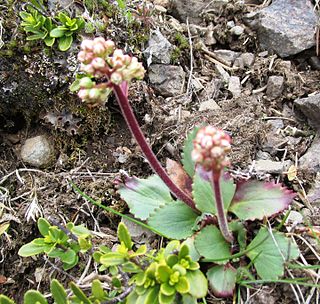
Galeopsis tetrahit, the common hemp-nettle or brittlestem hempnettle, is a flowering plant in the family Lamiaceae, native to Europe and northwestern Asia.

Primula pauciflora, the pretty shooting star, few-flowered shooting star, dark throat shooting star or prairie shooting star, is a species of flowering plant in the primula family Primulaceae. It is a widespread and very variable species, native to western North America, from Subarctic America to Mexico, often in xeric and desert habitats. It is found in the Great Basin Deserts and Mojave Desert. Its synonyms include Dodecatheon pauciflorum and Dodecatheon pulchellum.

Keckiella corymbosa is a species of flowering shrub in the plantain family known by the common names redwood keckiella, red beardtongue, and red shrubby penstemon.

Chaenactis douglasii is a North American species of flowering plant in the daisy family known by the common name Douglas' dustymaiden.

Penstemon floridus is a species of flowering plant in the plantain family known by the common names Panamint beardtongue and rose penstemon.

Penstemon thompsoniae, Thompson's beardtongue, is a low perennial plant endemic to the southwestern United States, where it grows in dry shrublands, woodlands and forests. It is considered a species of conservation concern in California.

Penstemon barrettiae is a species of flowering plant in the plantain family known by the common name Barrett's beardtongue or Barrett's penstemon. It is endemic to a small part of the Pacific Northwest of North America.

Penstemon eriantherus is a species of flowering plant in the plantain family known by the common names fuzzytongue penstemon and crested beardtongue. It is native to western North America, where it occurs in western Canada and the northwestern and north-central United States.

Erigeron poliospermus is a species of flowering plant in the family Asteraceae known by the common names gray-seeded fleabane, purple cushion fleabane, and hairy-seed fleabane. Native to western North America, it is mainly found to the east of the Cascade Range in Washington, Oregon, and Idaho.

Penstemon pennellianus, often called the Blue Mountain beardtongue or Blue Mountain penstemon, is a species of beardtongue native to Washington and Oregon.

Micranthes occidentalis, commonly known as western saxifrage, is a species of flowering plant native to North America.

Penstemon whippleanus, commonly known as dusky penstemon, dusky beardtongue, Whipple's penstemon, or Whipple's beardtongue, is a summer blooming perennial flower in the large Penstemon genus. It is a widespread plant within the hemiboreal forests of the Rocky Mountains in North America. It is noted for the large deep purple-red flowers and a preference for high mountain elevations.

Penstemon albidus, commonly known as white penstemon, white-flower beardtongue, or Red-Line Beardtongue is a very widespread perennial flower of the mixed-grass and shortgrass prairies. Its natural distribution is from Manitoba and Alberta in Canada to Texas and New Mexico in the United States. The bright white flowers for which they are named are quite attractive to both bees and hummingbird moths.

Penstemon secundiflorus, commonly known as sidebells penstemon, or orchid beardtoungue is a species of Penstemon that grows in dry forests, high plains, and scrub lands from Wyoming to Mexico. It is a herbaceous perennial plant that typically grows to a height of 20 to 50 cm and has narrow, lance-shaped leaves that are grayish-green in color. The flowers of the sidebells penstemon are tubular in shape and are arranged in a one-sided spike, with the blooms all facing the same direction, and for this reason was named "secundiflorus", which means "one-sided flowers". The flowers are most often delicate shades of orchid or lavender. It is sometimes used in xeriscaping, rock gardens, and wildflower meadows, and is well-suited to dry, sunny locations with well-draining soil.

Penstemon auriberbis, commonly known as the Colorado penstemon or Colorado beardtongue, is a species of Penstemon that grows in the shortgrass prairies of southern Colorado and in a few places in northern New Mexico. Although specimens were collected on the 1820 expedition by Stephen H. Long through the area, they were not scientifically described as a separate species until 1920.

Penstemon gairdneri is a species of perennial plant in the Plantaginaceae family with the common name Gairdner's beardtongue. It is native to Washington, Oregon, and Idaho in the western United States.

Ourisia simpsonii is a species of flowering plant in the family Plantaginaceae that is endemic to high-elevation habitats in the South Island of New Zealand. Mary Kalin Arroyo elevated O. simpsonii to species rank in 1984. Plants of this species of New Zealand mountain foxglove are perennial, small-leaved herbs that are covered in a mixture of long glandular and non-glandular hairs. They have hairy, crenate, ovate leaves that are in a basal rosette. The flowers are single or in pairs in each node, with a zygomorphic calyx and corolla. The corolla is white and the corolla tube is yellow and glabrous inside, and purple outside. It is listed as Not Threatened.

Ourisia sessilifolia subsp. splendida is a subspecies of flowering plant in the family Plantaginaceae that is endemic to high-elevation habitats in the South Island and Stewart Island of New Zealand. Joseph Dalton Hooker described O. sessilifolia in 1864. Plants of this subspecies of New Zealand mountain foxglove are perennial, small-leaved, rosette herbs that are covered in a mixture of short glandular hairs and long non-glandular hairs. They have hairy, crenate, ovate leaves that are in a basal rosette. The flowers are in pairs or whorls in each node, with a and regular calyx and a white regular corolla. The corolla tube is purple inside, with one line of white hairs inside, and purple outside. It is listed as Not Threatened.

Penstemon pruinosus is a species of flowering plant in the plantain family; its common name is the Chelan penstemon. It is native to Washington State and southern British Columbia on the east side of the Cascade Mountains.

Penstemon confertus is a species of flowering plant in the plantain family; its common name is the Yellow beardtoungue. It is native to the US states of Washington, Idaho, and Montana, and the Canadian provinces British Columbia and Alberta.























